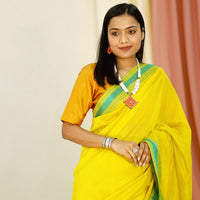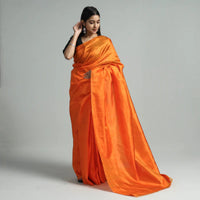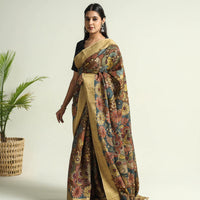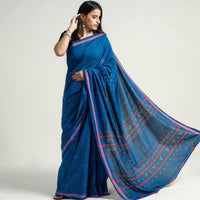Pochampally Sarees: A Masterpiece of Ikat Weaving Tradition
Pochampally sarees, also known as Pochampally Ikat sarees, are one of the most celebrated handwoven textiles in India, renowned for their intricate patterns and vibrant colors. These sarees originate from the village of Bhoodan Pochampally in the Yadadri Bhuvanagiri district of Telangana, a region steeped in history and cultural significance. Pochampally sarees have earned a unique place in the world of Indian textiles due to their distinctive ikat dyeing technique, which has been perfected by the weavers of this region over several generations.
The Rich History of Pochampally Weaving
The history of Pochampally weaving can be traced back over 200 years, to a time when the village of Bhoodan Pochampally was known as a hub of handloom weaving. The craft was initially patronized by the local kings and chieftains, who recognized the skill and artistry of the weavers. Over time, Pochampally sarees gained widespread popularity, becoming a symbol of the region’s cultural heritage.
The art of ikat weaving, known as “Chitki” in the local language, involves a complex resist-dyeing process that is believed to have originated in Southeast Asia and spread to India through trade routes. The weavers of Pochampally adopted and refined this technique, making it their own and creating sarees that are now synonymous with elegance and tradition.
The Intricate Process of Making Pochampally Sarees
Pochampally sarees are made using a labor-intensive process that requires precision, skill, and patience. The entire process, from dyeing the yarn to weaving the saree, is done by hand, ensuring that each saree is unique and carries the hallmark of traditional craftsmanship.
1. The Dyeing Process:
The making of a Pochampally saree begins with the dyeing of the yarn. The yarns, which are either cotton or silk, are carefully selected and bundled into small sections. These sections are then tightly tied with a resist material, usually made from rubber or plastic. The tied sections resist the dye, allowing the weaver to create intricate patterns on the yarn. This technique is known as “ikat” or “resist dyeing.”
The tied yarns are dipped into vats of dye, with the colors being applied in layers to achieve the desired pattern. This process is repeated several times, with the yarns being retied and redyed for each color. The result is a yarn that carries the pattern, which will be revealed when it is woven into fabric.
2. The Weaving Process:
Once the yarns are dyed, they are arranged on the loom in a specific order to align the patterns. This is one of the most challenging aspects of Pochampally weaving, as the weaver must ensure that the patterns on the warp (vertical threads) and weft (horizontal threads) align perfectly to create the intricate ikat designs.
The weavers use traditional pit looms, where they sit in a pit with the loom at ground level. This allows them to control the tension of the threads and achieve the precision required for ikat weaving. The weaving process itself is time-consuming, with a single saree taking anywhere from a week to several months to complete, depending on the complexity of the design.
3. Types of Pochampally Sarees:
Pochampally sarees come in a variety of styles, each offering a unique combination of fabric, pattern, and color. The diversity in these sarees reflects the creativity and expertise of the weavers, who continue to innovate within the framework of traditional ikat techniques.
• Pochampally Silk Sarees: These sarees are woven from pure silk threads, making them luxurious and ideal for special occasions. The silk used in these sarees adds a natural sheen, enhancing the vibrancy of the ikat patterns. Pochampally silk sarees are often adorned with intricate zari work on the borders and pallu, making them a popular choice for weddings and festivals.
• Pochampally Cotton Sarees: Known for their comfort and breathability, Pochampally cotton sarees are perfect for everyday wear. The lightweight fabric is easy to drape and is available in a wide range of colors and patterns, from simple geometric designs to more elaborate motifs. These sarees are highly durable and are a staple in many wardrobes across India.
• Pochampally Ikat Silk Sarees: These sarees combine the richness of silk with the intricate patterns of ikat weaving. The result is a saree that is both elegant and versatile, suitable for both formal and festive occasions. The ikat patterns in these sarees are often bold and vibrant, making them stand out in any setting.
• Pochampally Ikat Cotton Sarees: These sarees are similar to their silk counterparts but are made from cotton, offering a more casual and comfortable option. The ikat patterns in these sarees are typically more subdued, making them ideal for office wear or casual outings.
Colors and Symbolism in Pochampally Sarees
The colors used in Pochampally sarees are as varied as the patterns themselves, with each color carrying its own symbolism and cultural significance. The weavers of Pochampally use both natural and synthetic dyes to achieve the rich, vibrant hues that these sarees are known for.
• Red: A symbol of power, passion, and auspiciousness, red is a popular color in Pochampally sarees, especially for bridal and festive wear.
• Blue: Representing calmness, serenity, and stability, blue is often used in everyday wear sarees and is favored for its soothing effect.
• Yellow: Associated with spirituality, purity, and light, yellow is a color of celebration and is commonly seen in sarees worn during religious ceremonies.
• Green: Symbolizing fertility, prosperity, and life, green is a versatile color that is popular for both casual and formal sarees.
• Black: Traditionally considered inauspicious in some contexts, black has gained popularity in contemporary Pochampally sarees for its elegance and sophistication, making it a chic choice for modern fashion.
The Region and Communities Behind Pochampally Sarees
Bhoodan Pochampally, the birthplace of these exquisite sarees, is not just a village but a center of cultural and artistic excellence. The village is home to the Padmashali and Devanga communities, who have been the custodians of the ikat weaving tradition for centuries. These communities have preserved their craft through generations, adapting to changes in fashion while maintaining the integrity of their traditional techniques.
The region’s geographical location, with its proximity to the Krishna and Musi rivers, has also contributed to the development of the weaving industry. The rivers provide a reliable source of water for dyeing the yarns, while the fertile land around Pochampally supports the cultivation of cotton, which is essential for the production of these sarees.
Why Choose Pochampally Sarees from iTokri?
At iTokri, we take pride in offering an exclusive collection of Pochampally sarees, each one a reflection of the rich cultural heritage and artisanal skill of the weavers from Telangana. Our sarees are sourced directly from the weavers, ensuring that you receive an authentic product that is crafted with care and precision.
By purchasing a Pochampally saree from iTokri, you are not only adding a beautiful piece of traditional Indian attire to your wardrobe but also supporting the artisans who have dedicated their lives to preserving this ancient craft. We are committed to promoting sustainable and ethical practices, ensuring that every saree you buy contributes to the well-being of the artisan community.
Our collection of Pochampally sarees is diverse, offering something for everyone. Whether you are looking for a luxurious silk saree for a special occasion or a comfortable cotton saree for everyday wear, iTokri has the perfect saree for you. Each saree is carefully curated to maintain the authenticity and integrity of the Pochampally tradition, ensuring that you receive a garment that is both beautiful and culturally significant.
Explore the exquisite collection of Pochampally sarees at iTokri today and immerse yourself in the timeless elegance of this traditional craft. Whether you are drawn to the bold patterns of a Pochampally ikat silk saree or the understated elegance of a cotton saree, our collection offers something for every saree enthusiast. Shop now and experience the beauty of Pochampally sarees, crafted with love and care by skilled artisans.
Dil se shukriya for reading it till now :) You seem to be a true Saree lover :)
Hello! My name is Nitin and with Jia i am one of the founders at iTokri :)
We both have been true saree lovers since 2012 and a decade has passed since we started on this journey with love and passion.
Sarees have been one of the best-selling categories on iTokri since we ventured on to build the most diverse catalog of Indian Sarees on the internet keeping the spirit of artisanal heritage alive. Jia and myself travelled extensively through India's weavers communities trying to build a most authentic saree shop online with integrity and transparency at its core. With so much being crafted in India, we are not yet there what we aimed for... the journey seems to on and i can surely tell you its most exciting one!
We welcome you to explore our elaborated full saree catalog " here "
I would highly recommend you visit our other textile crafts too including running fabrics ofcourse and dress materials, dupattas, stoles, blouse materials and beautiful bedcovers, cushion covers and more, cherishing the skills of Indian Master Artisans.
Recently we also launched our exclusive garments label "ITOKRI CASUALS", Jia is heading the designs there, i would like to welcome you to explore our Kurtas, Suit Sets, Dresses, Co-ord Sets, Night Suits and much more.
It would be good to also check out our non-textile crafts in Jewellery, Home Decor, Stationery, Bags, and Kitchen catalogs .
We have also created a comprehensive & dedicated landing page for all the Indian crafts we have listed on iTokri here - CRAFTS OF INDIA
If you want to directly reach out to me, you can drop me an email at nitin@itokri.com and i shall be happy to connect with you :)
I wish you a happy browsing at iTokri! Looking forward to your lovely support!
FAQ Section:
1. What is a Pochampally saree?
• A Pochampally saree is a traditional Indian saree known for its intricate ikat weaving technique, originating from the town of Bhoodan Pochampally in Telangana. These sarees are famous for their vibrant geometric patterns and rich cultural heritage, often featuring a blend of cotton and silk.
2. How are Pochampally sarees made?
• Pochampally sarees are meticulously handwoven using the ikat dyeing technique. This involves tying and dyeing the yarn in specific patterns before weaving, which results in intricate designs that are perfectly aligned during the weaving process. The sarees are typically woven on traditional pit looms by skilled artisans.
3. What types of Pochampally sarees are available?
• iTokri offers a variety of Pochampally sarees including:
• Pochampally Silk Sarees: Luxurious sarees made entirely from silk, ideal for special occasions.
• Pochampally Ikat Cotton Sarees: These sarees combine comfort and traditional ikat designs, making them ideal for casual wear.
4. What makes Pochampally sarees unique?
• Pochampally sarees are unique because of their double ikat weaving technique, which requires precise alignment of patterns on both the warp and weft threads. This intricate process, combined with the use of vibrant colors and traditional geometric patterns, makes each saree a work of art.
5. How can I identify an authentic Pochampally saree?
• To identify an authentic Pochampally saree, look for the following features:
• Crisp Ikat Patterns: The patterns should be sharp and well-aligned, indicating the use of the traditional ikat technique.
• Handwoven Texture: The fabric should have a slightly uneven texture, characteristic of handwoven sarees.
• Traditional Borders: Authentic Pochampally sarees often feature zari borders with traditional motifs.
• Source: Purchase from trusted sellers like iTokri, who source directly from artisans to ensure authenticity.
6. What colors are commonly used in Pochampally sarees?
• Pochampally sarees come in a wide range of colors, each carrying its own symbolism:
• Red: Symbolizes power, passion, and auspiciousness, often used in bridal sarees.
• Blue: Represents calmness and serenity, popular for everyday wear.
• Green: Denotes fertility and prosperity, commonly chosen for auspicious occasions.
• Yellow: Associated with spirituality and purity, often seen in religious ceremonies.
• Black: While traditionally less common, black sarees have gained popularity for their elegance in contemporary fashion.
7. How should I care for my Pochampally saree?
• To ensure the longevity of your Pochampally saree:
• Dry Clean: Silk sarees should be dry cleaned to maintain their sheen and texture.
• Hand Wash: For cotton sarees, use cold water and a mild detergent. Avoid wringing the fabric.
• Proper Storage: Store the saree in a cool, dry place, preferably wrapped in a muslin cloth, to protect it from dust and moisture.
8. Are Pochampally sarees eco-friendly?
• Yes, Pochampally sarees are considered eco-friendly. The traditional weaving process uses minimal chemicals, especially in handloom sarees where natural dyes are often used. The manual weaving process also reduces energy consumption, making these sarees a sustainable fashion choice. Additionally, purchasing these sarees supports local artisans, contributing to sustainable livelihoods.
9. Which communities are involved in the weaving of Pochampally sarees?
• The weaving of Pochampally sarees is primarily carried out by the Padmashali and Devanga communities in Bhoodan Pochampally, Telangana. These communities have been practicing this craft for generations, preserving and perfecting the ikat weaving technique. The weaving process is often a family tradition, with skills being passed down through generations.
10. Can I find authentic Pochampally sarees online at iTokri?
• Absolutely! iTokri offers a curated collection of authentic Pochampally sarees, sourced directly from the artisans of Bhoodan Pochampally. Each saree is handwoven with care, ensuring that you receive a high-quality, genuine product. Shopping at iTokri not only guarantees authenticity but also supports the traditional artisans who create these beautiful sarees.
We are thrilled to show you our elaborated and authentic Handcrafted Saree Collection :)
Our Bestsellers other than Ikat sarees you saw above are : Bandhani or Bandhej Sarees, Kalamkari Sarees, Ajrakh Hand Block Print Silk & Cotton Sarees, Madhubani Painted Sarees, Original Mangalgiri Handloom Sarees, Sambalpuri Ikat Sarees of Odisha, Hand Batik Printed Silk & Cotton Sarees, Pure Cotton Sarees, Handwoven Pure Tussar Silk & Cotton Sarees
Check All Saree Collection " here "
पोचमपल्ली साड़ियाँ: इकत बुनाई की एक उत्कृष्ट कृति
पोचमपल्ली साड़ियाँ, जिन्हें पोचमपल्ली इकत साड़ियाँ भी कहा जाता है, भारत की सबसे प्रसिद्ध हस्तनिर्मित वस्त्रों में से एक हैं, जो अपनी जटिल डिज़ाइनों और जीवंत रंगों के लिए जानी जाती हैं। ये साड़ियाँ तेलंगाना के यदाद्रि भुवनागिरी जिले के भूदान पोचमपल्ली गाँव से उत्पन्न होती हैं, जो इतिहास और सांस्कृतिक महत्व से समृद्ध क्षेत्र है। पोचमपल्ली साड़ियों ने अपनी विशिष्ट इकत रंगाई तकनीक के कारण भारतीय वस्त्रों में एक अनूठा स्थान अर्जित किया है, जिसे इस क्षेत्र के बुनकरों ने कई पीढ़ियों से परिष्कृत किया है।
पोचमपल्ली बुनाई की समृद्ध इतिहास की जड़ें लगभग 200 साल पहले तक जाती हैं, जब भूदान पोचमपल्ली गाँव हस्तकरघा बुनाई का एक प्रमुख केंद्र था। इस शिल्प को स्थानीय राजाओं और प्रमुखों का संरक्षण प्राप्त था, जिन्होंने बुनकरों की कला और कौशल को मान्यता दी। समय के साथ, पोचमपल्ली साड़ियाँ व्यापक लोकप्रियता प्राप्त कर चुकी हैं और इस क्षेत्र की सांस्कृतिक धरोहर का प्रतीक बन गई हैं।
पोचमपल्ली साड़ियों का निर्माण एक श्रम-साध्य प्रक्रिया है, जिसमें सटीकता, कौशल और धैर्य की आवश्यकता होती है। यार्न को रंगाई से लेकर साड़ी बुनाई तक की पूरी प्रक्रिया हाथ से की जाती है, जिससे हर साड़ी अद्वितीय होती है और पारंपरिक हस्तकला का प्रतीक होती है।
पोचमपल्ली साड़ियों की विभिन्न शैलियाँ होती हैं, जो कपड़े, डिज़ाइन और रंगों का एक अनूठा संयोजन प्रस्तुत करती हैं। इनमें पोचमपल्ली रेशम साड़ियाँ, कपास साड़ियाँ, इकत रेशम साड़ियाँ और इकत कपास साड़ियाँ शामिल हैं। प्रत्येक साड़ी प्रकार विशेष अवसरों के लिए उपयुक्त होती है, जैसे कि शादी, उत्सव, और दैनिक पहनावा।
पोचमपल्ली साड़ियों के रंग भी विविध होते हैं, जिनमें से प्रत्येक का अपना सांस्कृतिक और प्रतीकात्मक महत्व होता है। ये साड़ियाँ लाल, नीला, हरा, पीला और काला जैसे रंगों में उपलब्ध होती हैं, जो परंपरा और आधुनिकता का मिश्रण प्रस्तुत करती हैं।
iTokri में, हम गर्व से एक विशेष पोचमपल्ली साड़ियों का संग्रह प्रस्तुत करते हैं, जिसमें से प्रत्येक साड़ी तेलंगाना के कुशल बुनकरों की समृद्ध सांस्कृतिक धरोहर और कारीगरी का प्रतिबिंब है। इन साड़ियों को चुनकर, आप न केवल एक सुंदर पारंपरिक भारतीय परिधान प्राप्त कर रहे हैं, बल्कि उन कारीगरों का भी समर्थन कर रहे हैं जिन्होंने इस प्राचीन शिल्प को संरक्षित करने के लिए अपने जीवन को समर्पित किया है।
This content has been thoughtfully generated with some help of AI tools available on the web and properly moderated with expert inputs to make it authentic and reader friendly. bahut jyada mehnat lagti hai usme bhi :)
The purpose of the content is to help you understand the product, its source and the people working behind it... and also the history and legacy of Indian craftsmanship. Its little detailed but i am sure worth the read if you have reached here already!
If you think that this content is helpful, do share your feedback on
whatsapp by clicking
" here " or write to us
on the dedicated email id :
content@itokri.com :)
If you don't find it helpful, we would love to hear some feedback from you and shall improve on our content generation strategy for sure.
The primary goal of iTokri is to enrich your learning around crafts and authentic products our beautiful country makes!








































































